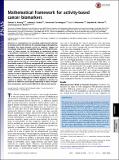Mathematical framework for activity-based cancer biomarkers
Author(s)
Kwong, Gabriel A.; Carrodeguas, Emmanuel; Mazumdar, Eric V.; Zekavat, Seyedeh M.; Dudani, Jaideep Sunil; Bhatia, Sangeeta N; ... Show more Show less
DownloadDudani-2015-Mathematical framework.pdf (1.210Mb)
PUBLISHER_POLICY
Publisher Policy
Article is made available in accordance with the publisher's policy and may be subject to US copyright law. Please refer to the publisher's site for terms of use.
Terms of use
Metadata
Show full item recordAbstract
Advances in nanomedicine are providing sophisticated functions to precisely control the behavior of nanoscale drugs and diagnostics. Strategies that coopt protease activity as molecular triggers are increasingly important in nanoparticle design, yet the pharmacokinetics of these systems are challenging to understand without a quantitative framework to reveal nonintuitive associations. We describe a multicompartment mathematical model to predict strategies for ultrasensitive detection of cancer using synthetic biomarkers, a class of activity-based probes that amplify cancer-derived signals into urine as a noninvasive diagnostic. Using a model formulation made of a PEG core conjugated with protease-cleavable peptides, we explore a vast design space and identify guidelines for increasing sensitivity that depend on critical parameters such as enzyme kinetics, dosage, and probe stability. According to this model, synthetic biomarkers that circulate in stealth but then activate at sites of disease have the theoretical capacity to discriminate tumors as small as 5 mm in diameter—a threshold sensitivity that is otherwise challenging for medical imaging and blood biomarkers to achieve. This model may be adapted to describe the behavior of additional activity-based approaches to allow cross-platform comparisons, and to predict allometric scaling across species.
Date issued
2015-10Department
Massachusetts Institute of Technology. Institute for Medical Engineering & Science; Harvard University--MIT Division of Health Sciences and Technology; Massachusetts Institute of Technology. Department of Biological Engineering; Massachusetts Institute of Technology. Department of Electrical Engineering and Computer Science; Koch Institute for Integrative Cancer Research at MITJournal
Proceedings of the National Academy of Sciences
Publisher
National Academy of Sciences (U.S.)
Citation
Kwong, Gabriel A., Jaideep S. Dudani, Emmanuel Carrodeguas, Eric V. Mazumdar, Seyedeh M. Zekavat, and Sangeeta N. Bhatia. “Mathematical Framework for Activity-Based Cancer Biomarkers.” Proc Natl Acad Sci USA 112, no. 41 (September 28, 2015): 12627–12632.
Version: Final published version
ISSN
0027-8424
1091-6490